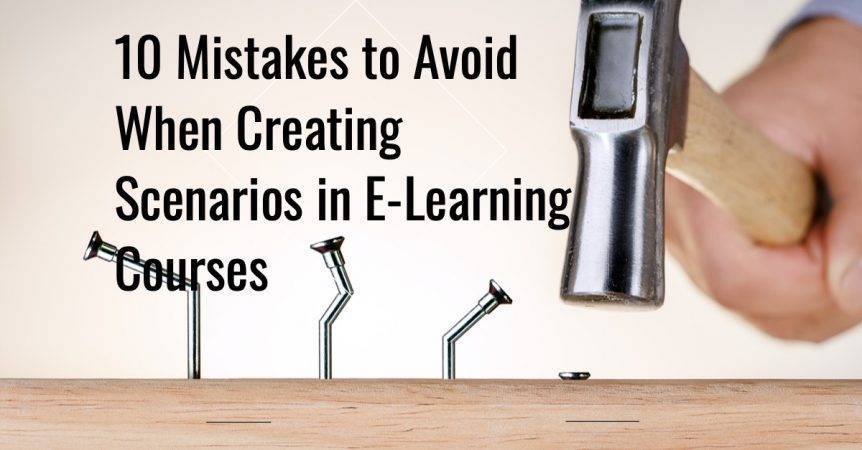Mistakes to Avoid When Creating Scenarios in E-Learning Courses
Scenarios are interactive content elements in e-learning courses that allow learners to practice and use their new skills and knowledge. Scenarios let learners do this in a safe environment where the scenario is part of the learning process, rather than something designed to test knowledge or capabilities.
This makes scenarios a powerful training tool. However, you can’t just throw a few questions together to create a scenario. Instead, scenarios require proper preparation and development to ensure they are effective.
The following are the most common mistakes that people make when creating scenarios for e-learning courses.
E-Learning Scenarios – Mistakes to Avoid
-
Not Planning or Creating a Structure
Even small scenarios can have complex structures that can result in problems if not fully planned in advance. For example, there might be pathways in the scenario that learners can take that leads them to a dead end.
Planning out the scenario and working on the structure will prevent these situations from arising.
-
Creating Scenarios that are Unrealistic
Engagement is one of the big benefits of using scenarios in your e-learning courses. You risk losing that engagement if the scenario is unrealistic, as learners will struggle to connect with it.
In addition, there is little benefit to your business if the scenario is unrealistic, as learners will be practicing in a situation that they will never encounter in real life.
-
Creating Scenarios that are Not Relevant to Learners
It is possible to create realistic scenarios that are not relevant to learners. This is most common when you are targeting the e-learning course at a wide group of people who have different day-to-day experiences. For example, they might have different roles in the organisation, or they might work at different locations.
While it won’t always be possible, making scenarios relevant to learners will improve engagement and produce better results.
-
Not Telling the Story
Again, you can come up with a realistic scenario but still run into problems if you don’t explain the setting or situation well enough, i.e., if you don’t tell the story well.
When you don’t include a good story with the scenario, learners might miss the sense of jeopardy, time pressure, or stress that occurs in real life that you want to mimic in the scenario.
-
Not Connecting Scenarios to Learning Objectives
Any scenario in your e-learning courses should connect to what you want to achieve. For example, if you want to improve customer service or safe working practices, the scenario should be based on these objectives.
So, for the customer service objective, the scenario is likely to have a setting where a member of staff is dealing with a customer. For the safe working scenario, the scenario is likely to involve a situation where the learner will need to follow the health and safety protocols they have just learned.
-
Making the Decisions Too Easy
Not challenging learners is another common problem found in e-learning scenarios. Remember, the objective of a scenario is not to help learners successfully navigate through the options you present them with. Instead, scenarios should improve understanding and learning.
Therefore, it is okay if learners make mistakes. You need to challenge them for this to happen, which means making sure the questions are not easy.
-
Making Some of the Decision Options Unrealistic
Another situation that is common in scenarios is where the decisions are challenging on the surface, but where in reality, some of the options are not realistic. This will have the same effect as the previous point, where the decision-making process becomes too easy.
The solution is to make the options available for learners both challenging and realistic.
-
Not Providing Feedback on Decisions Taken by Learners
Again, this point comes back to the fact that scenarios are training tools. Therefore, it is important to provide feedback to learners on the decisions they make. Ideally, you should present this feedback during the scenario and at the end to give the learner a better understanding of how they have done.
-
Make the Feedback Realistic
It’s also important to give realistic feedback. For example, don’t simply tell a learner that their decision is correct, as situations are rarely as black and white as this in the real world. Particularly for complex scenarios and topics, learners will be making decisions in shades of grey.
The best feedback is where you explain the consequences of the learner’s actions and decisions, and how those actions and decisions impact the overall path they took as they moved through the scenario.
-
Including Irrelevant Details
This point ties back to a previous point about the importance of telling a story when creating scenarios. While this is true, it is also possible to go too far by including irrelevant details. Often this happens to bulk out the scenario or in an attempt to make it more entertaining.
This is a mistake, however, as adding irrelevant details to scenarios will just get in the way of the learning process. In fact, this applies to most aspects of your e-learning courses, i.e., everything included should be there to facilitate the learning process. If it doesn’t, drop it.
Scenarios: An Effective E-Learning Tool
Scenarios can significantly enhance your e-learning course and improve satisfaction and engagement levels. With careful planning and proper implementation, you will maximise the benefits of this highly effective e-learning tool.
